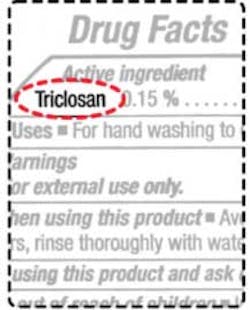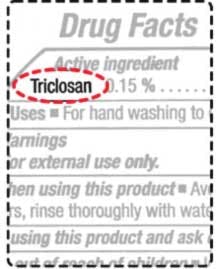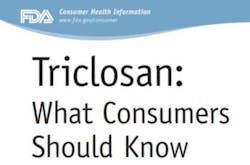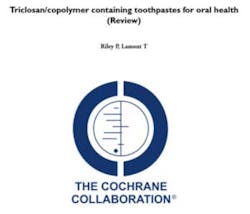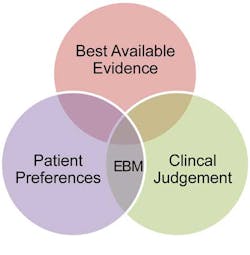Triclosan: the good, the bad, and the ugly
There has been much chatter lately on social media regarding triclosan, and products containing triclosan.
Allegations are being made that products contacting triclosan are being banned in certain countries and that it is an unsafe addition to oral care and other products. The “ugly” is that many of these accusations are unfounded and not based in science, and can blur the lines between personal preference and research. This article will attempt to present current evidence and allay some fears regarding the efficacy and safety of this product ingredient.
Triclosan has been used since 1972, and it is present in soaps (0.10-1.00%), shampoos, deodorants, toothpastes, mouth washes, and cleaning supplies, and is incorporated into an increasing number of consumer products, such as kitchen utensils, toys, bedding, socks, and trash bags. The purpose of triclosan is to reduce or prevent bacterial contamination. It is also found in health care settings in surgical scrubs and personnel hand washes.(1)
Triclosan has been shown to be effective in reducing and controlling bacterial contamination on the hands and on treated products. Showering or bathing with 2% triclosan has become a recommended regimen in surgical units for the decolonization of patients whose skin is carrying methicillin-resistant Staphylococcus aureus (MRSA) following the successful control of MRSA outbreaks in several clinical settings.(2) Triclosan is regulated by the U.S. Food and Drug Administration, the Environmental Protection Agency, and the European Union.
The Cochrane Review evaluated 30 studies dating from 1990 to 2012 in which 14,835 participants were randomized to receive either a triclosan/copolymer containing fluoride toothpaste or a traditional fluoride toothpaste that did not contain triclosan/copolymer. The toothpaste used in the studies containing the triclosan/copolymer system and fluoride was Colgate Total. The resulting data highlighted the many clinical benefits of using a triclosan/copolymer containing fluoride toothpaste and concluded there was no evidence of any harmful effects associated with the use of triclosan/copolymer toothpastes.(5)
Some important conclusions of the Cochrane Review include:
• After six or more months of use, fluoride toothpaste containing triclosan/copolymer provided a 22% reduction in plaque as compared with traditional fluoride toothpaste. It also provided a 41% reduction in plaque severity as compared with traditional fluoride toothpaste.
• After six or more months of use, fluoride toothpaste containing triclosan/copolymer provided a 22% reduction in gingivitis compared with traditional fluoride toothpaste. It provided a 48% reduction in gum bleeding compared with traditional fluoride toothpaste.
The ADA's Council on Scientific Affairs has independently reviewed data on the safety and effectiveness of triclosan /copolymer for reducing cavities, plaque and gingivitis, and awarded it the ADA Seal. The council concluded that there were sufficient clinical studies that showed these toothpastes reduced the incidence of cavities, the presence of plaque and gingivitis.(7) A company earns the ADA Seal for its product by providing evidence that meets the ADA criteria for safety and efficacy.
Authors’ conclusions: “There was moderate-quality evidence showing that toothpastes containing triclosan/copolymer, in addition to fluoride, reduced plaque, gingival inflammation and gingival bleeding when compared with fluoride toothpastes without triclosan/copolymer. These reductions may or may not be clinically important, and are evident regardless of initial plaque and gingivitis levels, or whether a baseline oral prophylaxis had taken place or not. High-quality evidence showed that triclosan/copolymer toothpastes lead to a small reduction in coronal caries. There was weaker evidence to show that triclosan/copolymer toothpastes may have reduced root caries and calculus, but insufficient evidence to show whether or not they prevented periodontitis. There do not appear to be any serious safety concerns regarding the use of triclosan/copolymer toothpastes in studies up to three years in duration.”(5)
While we all have personal favorites in products we use and recommend, it is a good idea to use evidence based medicine (EBM). Focus on the good, but always be wary of the bad and the ugly!
References
1. Food and Drug Administration (17 June 1994). "Federal Register Notice: Tentative Final Monograph for OTC Healthcare Antiseptic Drug Products - June 17, 1994."
2. Coia JE, Duckworth GJ, Edwards DI, et al. (May 2006). "Guidelines for the control and prevention of meticillin-resistant Staphylococcus aureus (MRSA) in healthcare facilities." J. Hosp. Infect. 63 Suppl 1: S1–44.
3. http://www.fda.gov/forconsumers/consumerupdates/ucm205999.htm.
4. Health Behavior News Service, part of the Center for Advancing Health. "Antibacterial agent boosts toothpaste effectiveness." ScienceDaily. www.sciencedaily.com/releases/2014/01/140109175500.htm (accessed February 13, 2014).
5. Riley P and Lamont T. for the Cochrane Oral Health Group. Triclosan/copolymer containing toothpastes for oral health. http://onlinelibrary.wiley.com/doi/10.1002/14651858.CD010514.pub2/abstract;jsessionid=217E52E32B87ADA7C2AD66C3244DFF12.f01t03. DOI: 10.1002/14651858.CD010514.pub2.
6. http://www.cochrane.org/.
7. http://www.ada.org/5275.aspx?productid=5254&company=Colgate-Palmolive+Co.
